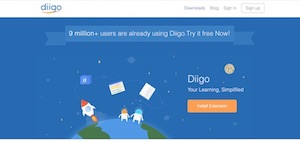At a Glance
What is it?
Website
Diigo

Diigo is a social bookmarking tool that enables you to search, bookmark, organize, archive, share, discuss, and annotate materials on the web. It's a useful tool for professional collaboration, student project collaboration, and for feedback and conversation between teachers and students. Diigo's unique feature—the ability to organize bookmarks in lists and groups (the equivalent of discrete file folders)—makes this a social bookmarking supermodel. You can also grab a snapshot or a screenshot of your bookmarked page to help jog your memory; highlight and attach sticky notes; and control who sees and who shares your bookmarks.
Getting Started
To get started with Diigo, simply create an account with username, email address, and password. You'll receive a confirmation email enabling you to activate your account. Then, install the Diigo toolbar according to directions for your browser; the toolbar enables you to access features quickly—including Diigo's highlighting and stickynote features. Once you have created your account, you can apply for an Educator Upgrade, which may take up to 48 hours to confirm. The most efficient way to maximize Diigo use is to watch the six-minute Take a Tour video and scan text highlights below the presentation to gain a sense of Diigo's possibilities.
Diigo allows you to highlight and attach sticky notes to specific parts of web pages you bookmark. Then, every time you return to your bookmarked page, these highlights and sticky notes remain—just as they do on hard copies. (Once you've joined Diigo, you may begin to notice sticky notes attached to a variety of sites—the New York Times for example.) Diigo users have the option of creating public, private, or shared annotations; it's up to you. Shared annotations allow you to continue threaded discussions with selected individuals or groups.
Examples
Bookmarking items of interest on the web can resemble photocopying dozens of documents and then throwing them in a pile on the desk. Just finding materials isn't enough; the next steps are classification, organization, and annotation—and Diigo features allow you and your students to create an organizational infrastructure for a variety of projects.
But it takes planning. The wiki Digitally Speaking: Social Bookmarking and Annotating by William Ferriter, is a general primer for social bookmarking, which Ferriter defines as collective intelligence, through examples using Diigo. Digitally Speaking identifies how students in all grade levels might utilize Diigo, and what skills Diigo allows them to use and practice in the course of developing projects and activities. The various entries linked through an introductory Table of Contents, include PDFs of examples of Diigo use, handouts, and tips and strategies for K-12 classrooms. For example, Digitally Speaking suggests introducing Diigo to your students through defining and assigning annnotation roles for effective, organized teamwork and collaboration: the Cannonball, Provacateur, and Middle Man for example; or, Original Thinker, Reliability Cop, and the Cleaning Crew. (Role titles and descriptions are available to download and handout.) You can also read a sample strand of of student-teacher annotation and interaction on the site of an archived news story. The Diigo entry concludes with an assessment tool with criteria to judge the quality of Diigo group annotating, commenting, and highlighting. An AP United States history teacher gives step-by-step directions and demonstrates student assignments with Diigo in this 11-minute YouTube video. Student Feedback with Diigo, a three-minute video on YouTube offers a specific example of how one teacher combines Google Groups and Diigo to give students feedback on their work.
For more information
The Ning group, Classroom 2.0 includes a discussion thread with examples of Diigo and purposes of social bookmarking as well as basic questions from teachers, to teachers about setting up Diigo accounts and student access. The Classroom 2.0 discussion thread New! Diigo Educator Accounts now available! is a discussion with question-and-answer commentary between Diigo administrators and classroom teachers. In December 2009, the American Association of School Librarians recognized Diigo as one of the top 25 Websites for Teaching and Learning.